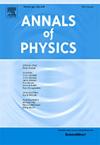变牛顿引力“常数”宇宙论
IF 3
3区 物理与天体物理
Q2 PHYSICS, MULTIDISCIPLINARY
引用次数: 0
摘要
我们证明了牛顿“常数”G的量子随机波动是允许真空在受到质量干扰时辐射霍金辐射所必需的,无论它是否是黑洞。我们从海森堡测不准原理推导出依赖于能量的牛顿引力“常数”G的最大量子涨落幅度,这使我们能够推导出G作为宇宙红移函数的变化的宇宙定律。对宇宙的弗里德曼-莱马本文章由计算机程序翻译,如有差异,请以英文原文为准。
Varying Newton gravitational “constant” cosmology
We demonstrate that quantum random fluctuations of Newton’s “constant”, , are required to allow the vacuum to radiate Hawking radiation when it is disturbed by a mass, whether it be a black hole or not. We deduce, from Heisenberg uncertainty principle, the maximum quantum fluctuation amplitude of an energy-dependent Newton gravitational “Constant” . This allows us to deduce a cosmic law for the variation of as a function of the cosmological redshift. Consequences for the Friedman–Lemaître–Robertson–Walker (FLRW) Model of the Universe are explored and the physical nature of the Dark Matter (DM) components of the cosmological fluid is revealed. It is also argued that oscillations of in black holes are a new physical mechanism for the emission of Gravitational Waves (GWs). Thus, conversion of part of the black hole rest mass into GW energy, through this mechanism, should occur in all black holes present in Active Galactic Nuclei (AGN) accounting for their luminosity and for the Stochastic Gravitational Wave Background (SGWB) recently detected by Timing Pulsar Array (TPA) teams. The presented data analysis obtains the result that fluctuations of Newton “constant” allow for explaining several Cosmology experimental results, such as: Hubble Tension, DM density, and fire wall paradox.
求助全文
通过发布文献求助,成功后即可免费获取论文全文。
去求助
来源期刊

Annals of Physics
物理-物理:综合
CiteScore
5.30
自引率
3.30%
发文量
211
审稿时长
47 days
期刊介绍:
Annals of Physics presents original work in all areas of basic theoretic physics research. Ideas are developed and fully explored, and thorough treatment is given to first principles and ultimate applications. Annals of Physics emphasizes clarity and intelligibility in the articles it publishes, thus making them as accessible as possible. Readers familiar with recent developments in the field are provided with sufficient detail and background to follow the arguments and understand their significance.
The Editors of the journal cover all fields of theoretical physics. Articles published in the journal are typically longer than 20 pages.
 求助内容:
求助内容: 应助结果提醒方式:
应助结果提醒方式:


